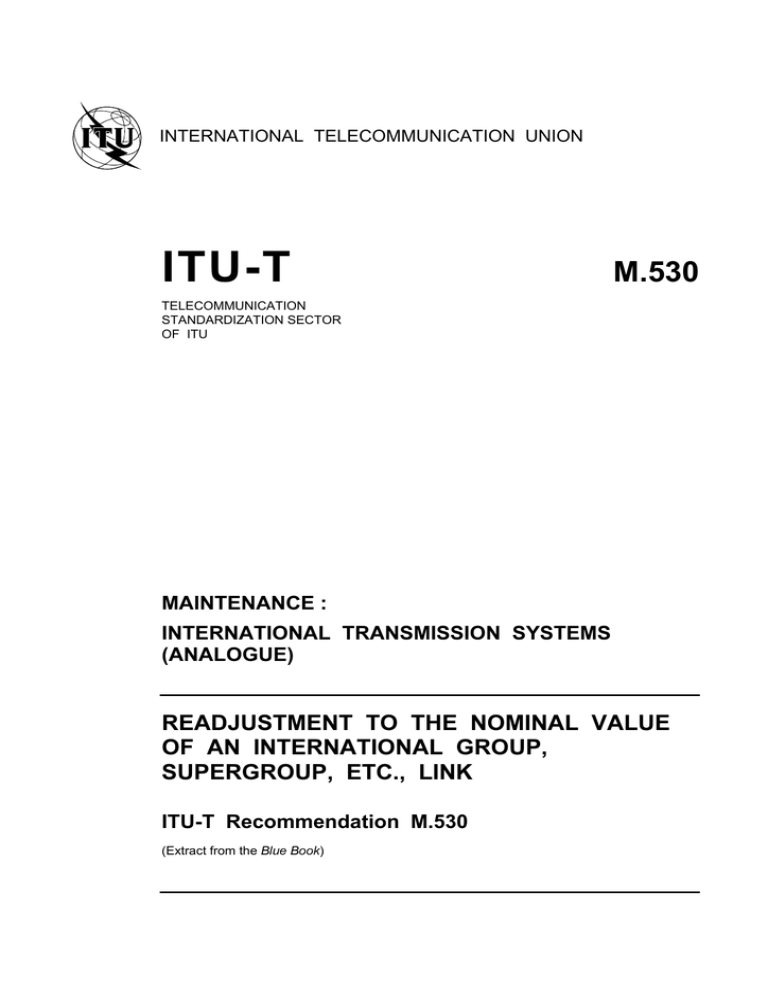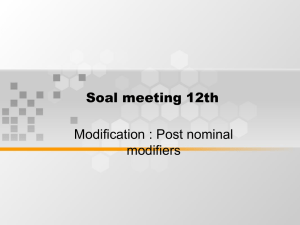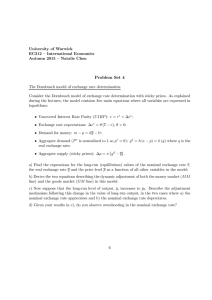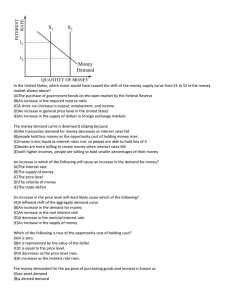ITU-T Rec. M.530 (11/88) Readjustment to the nominal value of an
advertisement

INTERNATIONAL TELECOMMUNICATION UNION )454 - TELECOMMUNICATION STANDARDIZATION SECTOR OF ITU -!).4%.!.#% ).4%2.!4)/.!, 42!.3-)33)/. 3934%-3 !.!,/'5% 2%!$*534-%.4 4/ 4(% ./-).!, 6!,5% /& !. ).4%2.!4)/.!, '2/50 350%2'2/50 %4# ,).+ )454 Recommendation - (Extract from the "LUE "OOK) NOTES 1 ITU-T Recommendation M.530 was published in Fascicle IV.1 of the Blue Book. This file is an extract from the Blue Book. While the presentation and layout of the text might be slightly different from the Blue Book version, the contents of the file are identical to the Blue Book version and copyright conditions remain unchanged (see below). 2 In this Recommendation, the expression “Administration” is used for conciseness to indicate both a telecommunication administration and a recognized operating agency. ITU 1988, 1993 All rights reserved. No part of this publication may be reproduced or utilized in any form or by any means, electronic or mechanical, including photocopying and microfilm, without permission in writing from the ITU. Recommendation M.530 Fascicle IV.1 - Rec. M.530 READJUSTMENT TO THE NOMINAL VALUE OF AN INTERNATIONAL GROUP, SUPERGROUP, ETC., LINK 1 General Before any adjustment is made to a link it must first be ensured that each regulated line section or higher-order link over which the link concerned is routed is correctly adjusted and that the level of the reference pilot at the transmitting end is correct. No readjustments will be made on the link except under the direction of the control station, after consideration of measurement results. 2 Links without a regulator 2.1 For links which use only one regulated line section, or one higher-order link, readjustment of levels to values as close as possible to their nominal value must be made systematically after any measurement or clearance of a fault. Any departure in excess of ± 2 dB from the original line-up at the time the link was first established must be investigated to ensure that there is no fault. 2.2 For links of more complex constitution, no readjustment need be made until the departure from the nominal value exceeds 0.5 dB (see the Note in § 3 of this Recommendation). When the departure from the nominal value exceeds these limits, adjustment to a value as near as possible to the nominal value should be carried out. Adjustment at the terminal station only is permissible within the limits of departure from the settings at the time of the previous reference measurements as a function of the distance to the origin of the link or to the nearest upstream automatic regulator, as given in Table 1/M.530. TABLE 1/M.530 Distance to origin or regulator Limit for departure from the settings noted for previous reference measurements beyond which the possibility of a fault should be investigated (see the note in § 3 of this Recommendation) Up to 1000 km......................................... ± 2 dB 1000-2000 km ......................................... ± 3 dB Above 2000 km ....................................... ± 4 dB If, for the distance concerned, adjustment at the terminal station would cause departures greater than those permitted by the table, measurements should be made at all through-connection points to find if a fault exists. If a fault exists, it should be located and cleared. If no fault exists, but the change is due to normal causes, e.g. temperature changes, aging, etc., adjustments should be made at each through-connection point to bring the level of the reference pilot as near as possible to its nominal value before making a final adjustment at the terminal station. 3 Links with a regulator No readjustment need be made until the departure from the nominal value measured at the input to the regulator exceeds ± 4 dB. Any departure in excess of ± 4 dB from the nominal value measured at this point must be investigated. Fascicle IV.1 - Rec. M.530 1 Note – In determining the margins within which equipment should be readjusted, it has been found useful to distinguish three ranges about the nominal value into which the received level might fall: – a relatively small range in which no action need be taken. This enables the staff to avoid waste of time in continually readjusting in order to compensate minor changes; – a somewhat larger range in which the received level may be readjusted to as near the nominal value as possible by the terminal station, without having to ask intermediate stations to measure and/or readjust. (This is subject to the overriding proviso that the cumulative adjustment made at the terminal station must not exceed a certain amount relative to the settings noted when the last set of reference measurements was made); – a range in which it must be assumed that a fault may exist which must be sought and cleared before any readjustment is permitted. After the fault (if any) has been found and all stations, intermediate and terminal, have, if necessary, readjusted their levels to as near the nominal value as possible, the new settings are noted for future reference purposes when making subsequent adjustments. The three ranges are shown in Figure 1/M.530 in relation to a typical distribution of level values. A suitable value for y in Figure 1/M.530 is considered to be 2 S, where S is the observed standard deviation. This concept is the basis of Table 1/M.530. d01-sc FIGURE 1/M.530...[D01] = 2 Fascicle IV.1 - Rec. M.530





